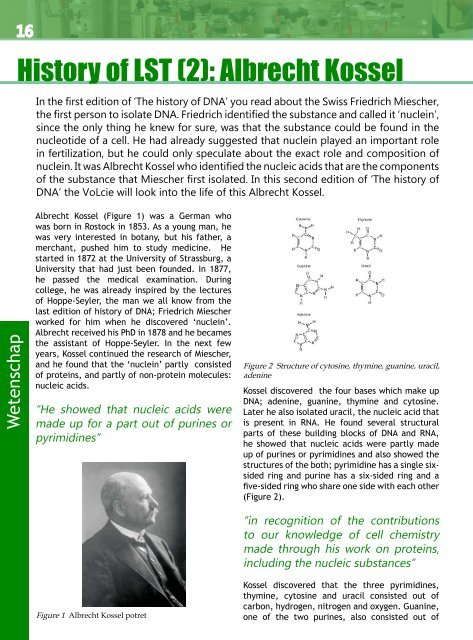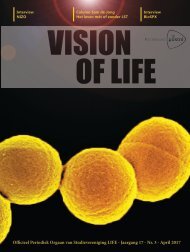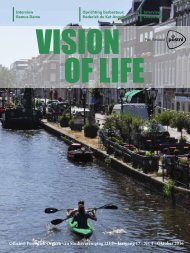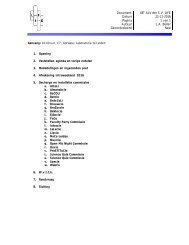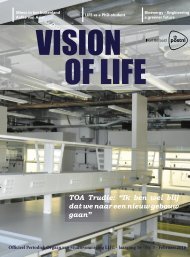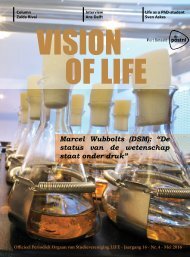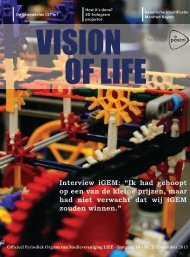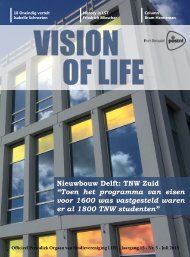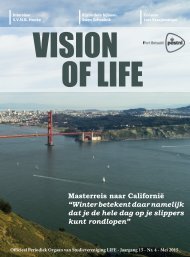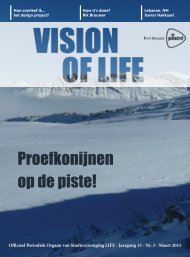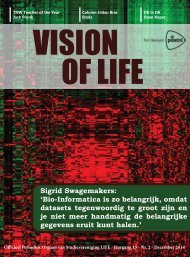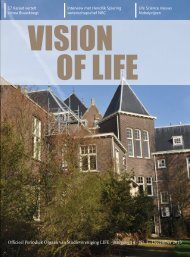Create successful ePaper yourself
Turn your PDF publications into a flip-book with our unique Google optimized e-Paper software.
<strong>16</strong><br />
17<br />
History <strong>of</strong> LST (2): Albrecht Kossel<br />
Wetenschap<br />
In the first edition <strong>of</strong> ‘The history <strong>of</strong> DNA’ you read about the Swiss Friedrich Miescher,<br />
the first person to isolate DNA. Friedrich identified the substance and called it ‘nuclein’,<br />
since the only thing he knew for sure, was that the substance could be found in the<br />
nucleotide <strong>of</strong> a cell. He had already suggested that nuclein played an important role<br />
in fertilization, but he could only speculate about the exact role and composition <strong>of</strong><br />
nuclein. It was Albrecht Kossel who identified the nucleic acids that are the components<br />
<strong>of</strong> the substance that Miescher first isolated. In this second edition <strong>of</strong> ‘The history <strong>of</strong><br />
DNA’ the VoLcie will look into the life <strong>of</strong> this Albrecht Kossel.<br />
Albrecht Kossel (Figure 1) was a German who<br />
was born in Rostock in 1853. As a young man, he<br />
was very interested in botany, but his father, a<br />
merchant, pushed him to study medicine. He<br />
started in 1872 at the University <strong>of</strong> Strassburg, a<br />
University that had just been founded. In 1877,<br />
he passed the medical examination. During<br />
college, he was already inspired by the lectures<br />
<strong>of</strong> Hoppe-Seyler, the man we all know from the<br />
last edition <strong>of</strong> history <strong>of</strong> DNA; Friedrich Miescher<br />
worked for him when he discovered ‘nuclein’.<br />
Albrecht received his PhD in 1878 and he becames<br />
the assistant <strong>of</strong> Hoppe-Seyler. In the next few<br />
years, Kossel continued the research <strong>of</strong> Miescher,<br />
and he found that the ‘nuclein’ partly consisted<br />
<strong>of</strong> proteins, and partly <strong>of</strong> non-protein molecules:<br />
nucleic acids.<br />
“He showed that nucleic acids were<br />
made up for a part out <strong>of</strong> purines or<br />
pyrimidines”<br />
Figure 2 Structure <strong>of</strong> cytosine, thymine, guanine, uracil,<br />
adenine<br />
Kossel discovered the four bases which make up<br />
DNA; adenine, guanine, thymine and cytosine.<br />
Later he also isolated uracil, the nucleic acid that<br />
is present in RNA. He found several structural<br />
parts <strong>of</strong> these building blocks <strong>of</strong> DNA and RNA,<br />
he showed that nucleic acids were partly made<br />
up <strong>of</strong> purines or pyrimidines and also showed the<br />
structures <strong>of</strong> the both; pyrimidine has a single sixsided<br />
ring and purine has a six-sided ring and a<br />
five-sided ring who share one side with each other<br />
(Figure 2).<br />
“in recognition <strong>of</strong> the contributions<br />
to our knowledge <strong>of</strong> cell chemistry<br />
made through his work on proteins,<br />
including the nucleic substances”<br />
these four atoms, but adenine, the other purine,<br />
did not contain any oxygen (Figure 2).<br />
“The influence <strong>of</strong> Kossel became<br />
larger and larger, ... he became the<br />
director <strong>of</strong> the chemical division <strong>of</strong> the<br />
institute <strong>of</strong> physiology in Berlin.”<br />
The influence <strong>of</strong> Kossel became larger and<br />
larger; in 1881 he qualified as lecturer and he<br />
became the director <strong>of</strong> the chemical division <strong>of</strong><br />
the institute <strong>of</strong> physiology in Berlin. In 1887 he<br />
became extraordinary pr<strong>of</strong>essor in the medical<br />
faculty <strong>of</strong> Freiburg and later in Marburg, where<br />
he also became the director <strong>of</strong> the institute<br />
<strong>of</strong> physiology. Some years later he moved to<br />
Heidelberg and became the chairman <strong>of</strong> the<br />
seventh international Congress <strong>of</strong> Physiology,<br />
and for two years he was the pro-rector <strong>of</strong> the<br />
University there. His influence was not only<br />
present in Germany, Kossel was also honorary<br />
doctor <strong>of</strong> the Universities <strong>of</strong> Cambridge, Dublin,<br />
Ghent, St Andrews and Edinburgh and he was the<br />
member <strong>of</strong> some academies as the Royal Swedish<br />
Academy <strong>of</strong> Science and the Royal Society <strong>of</strong><br />
Uppsala.<br />
During the nineties, he shifted the subject <strong>of</strong> his<br />
investigations from the cell nucleus to proteins.<br />
For instance, he studied the effects <strong>of</strong> a phenetole<br />
diet on urine, peptonic components <strong>of</strong> the cell<br />
and in 1896 he discovered an important protein<br />
Figure 4 Nobel prize documentation<br />
which we LST students all know: histone. Histones<br />
are the proteins that help package DNA into the<br />
structural units called nucleosomes (Figure 3).<br />
In 1910 Albrecht Kossel’s work on the discovery <strong>of</strong><br />
the five nucleic acids was rewarded: he received<br />
the Nobel prize in Physiology <strong>of</strong> Medicine “in<br />
recognition <strong>of</strong> the contributions to our knowledge<br />
<strong>of</strong> cell chemistry made through his work on<br />
proteins, including the nucleic substances”<br />
(Figure 4).<br />
“He found that the ‘nuclein’ consisted<br />
for a part out proteins, and for a part<br />
out <strong>of</strong> a non-protein molecules”<br />
Two years later Kossel gave a famous lecture in<br />
which he explained the importance <strong>of</strong> nucleic<br />
acids and the cellular proteins, which he<br />
dsicovered, as the chemical basis for genetics, in<br />
which he was completely right.<br />
Kossel was married with Luise Holtzmann and<br />
had a daughter and a son, Walther. Walther also<br />
became famous as a scientist, as he discovered<br />
X-ray interference in crystals. Albrecht Kossel<br />
died on July 5, 1927 after a short sickbed.<br />
Jolanda ter Horst<br />
Wetenschap<br />
Figure 1 Albrecht Kossel potret<br />
Kossel discovered that the three pyrimidines,<br />
thymine, cytosine and uracil consisted out <strong>of</strong><br />
carbon, hydrogen, nitrogen and oxygen. Guanine,<br />
one <strong>of</strong> the two purines, also consisted out <strong>of</strong><br />
Figure 3 Nucleosomes


